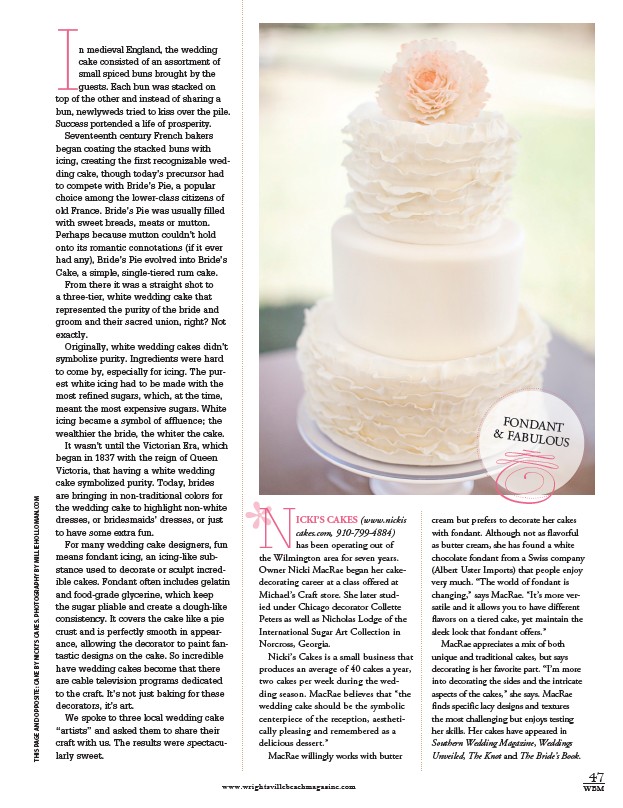
47
fondant
& Fabulous
u
www.wrightsvillebeachmagazine.com WBM
In medieval England, the wedding
cake consisted of an assortment of
small spiced buns brought by the
guests. Each bun was stacked on
top of the other and instead of sharing a
bun, newlyweds tried to kiss over the pile.
Success portended a life of prosperity.
Seventeenth century French bakers
began coating the stacked buns with
icing, creating the first recognizable wed-ding
cake, though today’s precursor had
to compete with Bride’s Pie, a popular
choice among the lower-class citizens of
old France. Bride’s Pie was usually filled
with sweet breads, meats or mutton.
Perhaps because mutton couldn’t hold
onto its romantic connotations (if it ever
had any), Bride’s Pie evolved into Bride’s
Cake, a simple, single-tiered rum cake.
From there it was a straight shot to
a three-tier, white wedding cake that
represented the purity of the bride and
groom and their sacred union, right? Not
exactly.
Originally, white wedding cakes didn’t
symbolize purity. Ingredients were hard
to come by, especially for icing. The pur-est
white icing had to be made with the
most refined sugars, which, at the time,
meant the most expensive sugars. White
icing became a symbol of affluence; the
wealthier the bride, the whiter the cake.
It wasn’t until the Victorian Era, which
began in 1837 with the reign of Queen
Victoria, that having a white wedding
cake symbolized purity. Today, brides
are bringing in non-traditional colors for
the wedding cake to highlight non-white
dresses, or bridesmaids’ dresses, or just
to have some extra fun.
For many wedding cake designers, fun
means fondant icing, an icing-like sub-stance
used to decorate or sculpt incred-ible
cakes. Fondant often includes gelatin
and food-grade glycerine, which keep
the sugar pliable and create a dough-like
consistency. It covers the cake like a pie
crust and is perfectly smooth in appear-ance,
allowing the decorator to paint fan-tastic
designs on the cake. So incredible
have wedding cakes become that there
are cable television programs dedicated
to the craft. It’s not just baking for these
decorators, it’s art.
We spoke to three local wedding cake
“artists” and asked them to share their
craft with us. The results were spectacu-larly
sweet.
Nicki’s Cakes (www.nickis
cakes.com, 910-799-4884)
has been operating out of
the Wilmington area for seven years.
Owner Nicki MacRae began her cake-decorating
career at a class offered at
Michael’s Craft store. She later stud-ied
under Chicago decorator Collette
Peters as well as Nicholas Lodge of the
International Sugar Art Collection in
Norcross, Georgia.
Nicki’s Cakes is a small business that
produces an average of 40 cakes a year,
two cakes per week during the wed-ding
season. MacRae believes that “the
wedding cake should be the symbolic
centerpiece of the reception, aestheti-cally
pleasing and remembered as a
delicious dessert.”
MacRae willingly works with butter
cream but prefers to decorate her cakes
with fondant. Although not as flavorful
as butter cream, she has found a white
chocolate fondant from a Swiss company
(Albert Uster Imports) that people enjoy
very much. “The world of fondant is
changing,” says MacRae. “It’s more ver-satile
and it allows you to have different
flavors on a tiered cake, yet maintain the
sleek look that fondant offers.”
MacRae appreciates a mix of both
unique and traditional cakes, but says
decorating is her favorite part. “I’m more
into decorating the sides and the intricate
aspects of the cakes,” she says. MacRae
finds specific lacy designs and textures
the most challenging but enjoys testing
her skills. Her cakes have appeared in
Southern Wedding Magazine, Weddings
Unveiled, The Knot and The Bride’s Book.
this page and opposite: Cake by Nicki’s Cakes. Photography by millieholloman.com
*